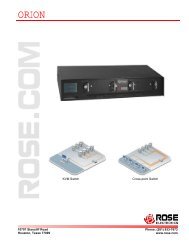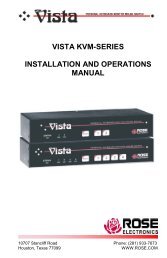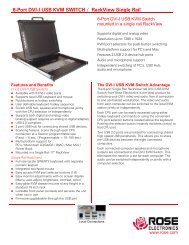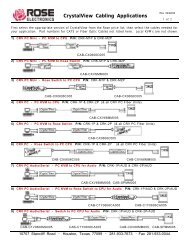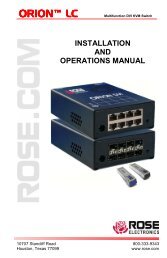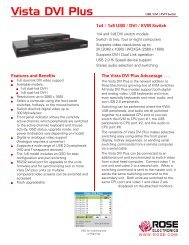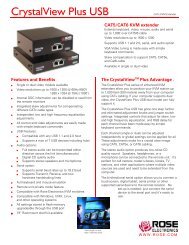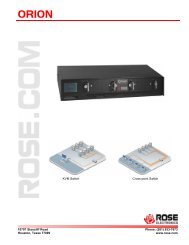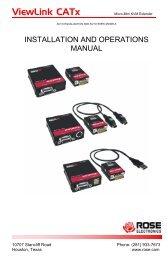Manual (PDF) - Rose Electronics
Manual (PDF) - Rose Electronics
Manual (PDF) - Rose Electronics
Create successful ePaper yourself
Turn your PDF publications into a flip-book with our unique Google optimized e-Paper software.
Address ranges<br />
Although you can define ranges of addresses, due to the way the mask operates, there are<br />
certain restrictions on the particular ranges that can be set. For any given address you can<br />
encompass neighboring addresses in blocks of either 2, 4, 8, 16, 32, 64, 128, etc. and these<br />
must fall on particular boundaries. For instance, if you wanted to define the local address<br />
range:<br />
192.168.142.67 to 192.168.142.93<br />
The closest single block to cover the range would be the 32 addresses from:<br />
192.168.142.64 to 192.168.142.95.<br />
The mask needed to accomplish this would be: 255.255.255.224<br />
When you look at the mask in binary, the picture becomes a little clearer. The above mask has<br />
the form: 11111111.11111111.11111111.11100000<br />
Ignoring the initial three octets, the final six zeroes of the mask would ensure that the 32<br />
addresses from .64 (01000000) to .95 (01011111) would all be treated in the same manner.<br />
See Net masks - the binary explanation for details.<br />
When defining a mask, the important rule to remember is:<br />
There must be no ‘ones’ to the right of a ‘zero’.<br />
For instance, (ignoring the first three octets) you could not use a mask that had 11100110<br />
because this would affect intermittent addresses within a range in an impractical manner. The<br />
same rule applies across the octets. For example, if you have zeroes in the third octet, then all<br />
of the fourth octet must be zeroes.<br />
The permissible mask values (for all octets) are as follows:<br />
Mask octet Binary Number of addresses encompassed<br />
255 111111111 address<br />
254 111111102 addresses<br />
252 111111004 addresses<br />
248 111110008 addresses<br />
240 1111000016 addresses<br />
224 1110000032 addresses<br />
192 1100000064 addresses<br />
128 10000000128 addresses<br />
0 00000000256 addresses<br />
If the access control range that you need to define is not possible using one address and one<br />
mask, then you could break it down into two or more entries. Each of these entries could then<br />
use smaller ranges (of differing sizes) that, when combined with the other entries, cover the<br />
range that you require.<br />
For instance, to accurately encompass the range in the earlier example:<br />
192.168.142.67 to 192.168.142.93<br />
You would need to define the following six address / mask combinations in the IP access<br />
control section:<br />
Network/address entry Mask entry<br />
192.168.142.67 255.255.255.255 defines 1 address (.67)<br />
192.168.142.68 255.255.255.252 defines 4 addresses (.68 to .71)<br />
192.168.142.72 255.255.255.248 defines 8 addresses (.72 to .79)<br />
192.168.142.80 255.255.255.248 defines 8 addresses (.80 to .87)<br />
192.168.142.88 255.255.255.252 defines 4 addresses (.88 to .92)<br />
192.168.142.93 255.255.255.255 defines 1 address (.93)<br />
Mask<br />
Enter an IP network mask that indicates the range of addresses that will be allowed or denied<br />
access. For instance, if only a single specified IP address were required, the mask entry would<br />
be 255.255.255.255 in order to specify a single location.<br />
Vista Remote 2 Installation and Operations <strong>Manual</strong> 51



